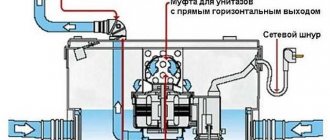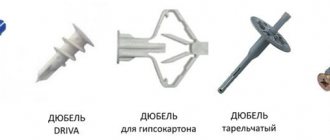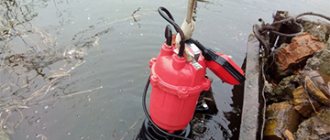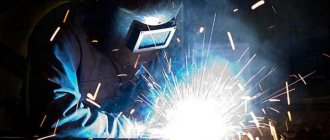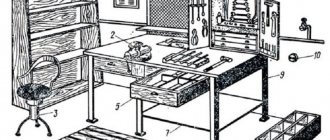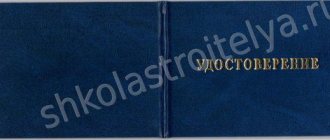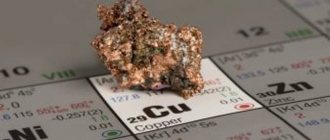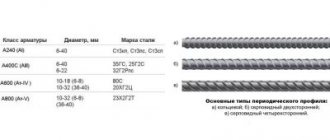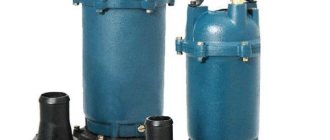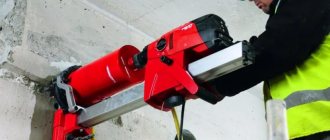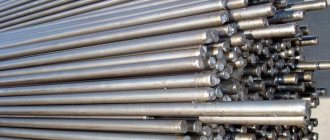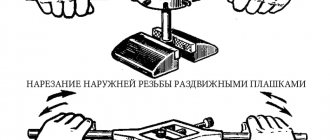Basic requirements for welding suits
In the mass production of any workwear, there are a number of requirements:
Practicality and laconicism of the silhouette of the jacket and trousers and the greatest comfort in movement. It is necessary to have soft padding in the knees and elbows in order to have additional protection from impacts in hard-to-reach places.
Treatment of workwear with water-repellent impregnation. This is a general requirement for all types of workwear.
Convenience for the welder is an important criterion. The jacket should not be too big and dangling, but also not restrict any movement. The sleeves should also fit close to the body. Otherwise, work productivity will be reduced.
Oil stains on workwear are excluded to prevent fire.
Torn edges (tears) of fabric, as well as abrasions, are unacceptable. Such minor injuries are dangerous due to burns. When working with welding, the worker must wear a dark, thick shirt with a collar and long sleeves with cuffs under the jacket. This will provide additional protection for your hands and throat.
The use of synthetics for special molds is unacceptable. They will ignite instantly and are therefore dangerous.
The shape should not be deformed during operation, made from environmentally friendly materials. The uniform must provide good ventilation to prevent the person from overheating.
Requirements for workwear
According to the standards, the jacket must cover the trousers and overalls by at least 2 cm, so that splashes of hot metal and sparks from the welding machine do not get under the clothes. One-piece overalls in this sense are more practical and safer. The model is also ideal for outdoor work.
All clothing has seasonal variations. Summer models are equipped with good ventilation, weigh little and do not restrict movement. Winter styles are well insulated from the inside. All types of fasteners are hidden by an additional screen made of fire-resistant fabric so that the fittings do not melt under the influence of elevated temperatures. Additionally, the fabrics are treated with waterproof impregnation, protecting against rain and snow.
Photo of a good welder's suit
Recommendations from experts
Experienced professionals advise following these guidelines when choosing protective clothing:
In summer, a summer variation of canvas, suede or split leather equipment is best suited for outdoor welding and indoor work. In the cold season, welding work is allowed only in winter uniform. Matching clothing can be removed much faster in the event of a fire
This is its advantage over the combined one. The comfort of the suit is important. It is optimal if the overalls are equipped with slits to ensure the best ventilation.
Modern manufacturers produce a huge range of welding suits. Before you buy this type of workwear, you need to carefully analyze the planned working conditions.
Trying on will not be superfluous. We hope that this article will help you make the right choice.
Manufacturers
Leading manufacturers of winter suits made from various materials are presented below.
Avangard-Spetsodezhda is a manufacturer and supplier of work and special clothing, footwear, and personal protective equipment. The company offers clients high-tech solutions at affordable prices.
Vostok-Service is an international company, a leading Russian developer, manufacturer and supplier of a wide range of special clothing, footwear, and personal protective equipment.
The company “Ivspetsposhiv” is engaged in the production of protective clothing for representatives of various fields of industry, as well as accessories and devices.
“Rodnikovskaya Spetsodezhda” is a sewing company specializing in the manufacture and wholesale of work and corporate clothing, as well as footwear and personal protective equipment.
The company “Spets Project” is engaged in the development, production and sale of work and special clothing, hats, and additional protective accessories.
Technoavia is a manufacturer of special, work and uniform clothing made from various materials, as well as shoes, accessories, hats and personal protective equipment.
Unicom-Spetskomplekt is a manufacturer of high-quality custom-made clothing and mass-produced equipment.
The remaining leading manufacturers of special suits for welders are presented in a separate article.
Protection classes
Manufacturers of workwear produce special markings for suits. It indicates the standard number and protective class. According to GOST regulations, there are only 3 such classes.
- This equipment is intended for workers located at a distance of at least 2 meters from the source of splashes of hot metal or sparks. They are used for welding work on specialized lines, as well as for cutting metal structures.
- Suits with protection class 2 are intended for use indoors and in open areas. In this case, the worker must be at a distance of 50 cm from the source of sparks.
- Class 3 overalls are used when carrying out welding work in closed spaces (for example, in tanks or pipelines). The distance to the source should be about 0.5 m.
Requirements for clothing for welding work
Welding equipment must meet the following requirements:
The cut of welding clothing must be concise. Clothing should be made from fire-resistant, burn-resistant fabric. The presence of additional soft pads in the elbows and knees will protect these parts of the body from mechanical damage. Like any workwear, welding uniforms must be treated with a special water-repellent compound. An important quality for a welder’s suit is comfort and lack of discomfort when worn. The fit of the open parts of the welding clothing to the body must be tight, otherwise the risk of drops of hot metal getting on the skin increases. The clasp must be tight and the collar must fit to the neck. High quality seams.
The welder's clothing must comply with all provisions of GOST welding suits, only then can welding work begin.
Requirements for welder clothing:
- All suits for welders must comply with the requirements of regulatory documents GOST 12.4.045-87, GOST 12.4.029-76, TU 1708-327-91, TU 8572-017-00302190-93
- Resistant to high temperatures;
- Resistance to deformation at elevated temperatures;
- Protection of the worker from overheating (presence of ventilation holes);
- Comfortable clothing;
- Burn-through resistance (increased protection against sparks and metal splashes) for a minimum of 50 seconds.
Protective functions
The welding profession is considered one of the most dangerous in the production of welding arcs and electrodes.
Therefore, each performer must have a comfortable welding suit and a mask to protect against the negative effects listed above on the human body. In addition, work often has to be performed at heights and in other conditions that are not very comfortable, where there is a high risk of injury from accidental falling of tools and devices.
Kit contents
Choosing clothing for welding work is a serious and painstaking matter:
- First, you need to protect your face and hands; mittens, gloves, a shield or a comfortable helmet are designed for this.
- Secondly, care must be taken to protect the performer’s entire body.
- And the third option is a respirator that protects the respiratory system from harmful gases.
If the performer works in safety glasses, then it is necessary to use a headgear made of dense and fire-resistant material in the form of a cap that covers the entire head and ears.
A basic welder's suit consists of a jacket, trousers and shoes made of thick leather; a common material is tarpaulin, from which boots or shoes are sewn. The trousers are sewn with an even cover, and on the welder's jacket only patch pockets with flaps with Velcro or with fasteners are allowed. This style eliminates the retention of sparks or hot slag particles on the surface of protective clothing.
Additional items of workwear
Since welders often have to work in a sitting and standing position, a leather apron that can cover almost the entire body would be useful for the welding suit they use. If metal or slag particles accidentally get on the apron, they will not cause damage to the workwear. A set of winter clothing for a welder should contain warm mittens or gloves with gauntlets. The robe must have special ventilation holes. The fact is that it is made of high-density material and can be hot in it.
The welder's shoes must meet special requirements. These are usually shoes or boots, the soles of which must be made using special non-stick rubber, which can protect the shoes from exposure to flame and electricity.
Shields and masks
From all of the above, it becomes clear that a welder needs a suit to protect his body. What about the eyes, which can be seriously damaged by burns and radiation? For this purpose, manufacturers offer special shields, which over time were replaced by special masks made of cardboard and “Chameleon” masks. Special glasses can also be used to protect the eyes.
- Today, shields are used very rarely due to the fact that they are very inconvenient to use during work. The worker has to hold the shield with one hand and do the work with the other.
- A mask made of thick cardboard with a viewing window made of a light filter is much better suited for this. But it also has a serious drawback - first the person must look at the place of work and only then lower the mask with a nod of the head or hand. However, even in these few seconds his vision can be seriously damaged.
- The Chameleon mask is a more practical way to protect your eyes because it does not need to be lifted before use. Here glass is used as a replacement for a light filter, which darkens when the arc is ignited. If necessary, an employee can customize such a mask to suit his needs. Thus, he will be able to create the most comfortable working conditions for himself.
Welders' jobs involve high health risks as they regularly face exposure to high temperatures, metal spatter, slag particles and sparks that can cause severe burns and injuries. In order to protect against such phenomena, they must perform their work only in a special welding suit.
However, these clothes must meet certain requirements and take into account their working conditions.
Particular attention here should be paid to the material from which the welder’s workwear is made. It should not only provide reliable protection from adverse factors, but also provide the worker with fairly comfortable conditions for welding work
The quality of the welding suit is no less important. To increase strength, the weakest points should have reinforced pads to reduce the risk of damage and thereby increase worker safety
It is also important to ensure that not only the body, but also the eyes are protected during work. To do this, a set of welding clothing must include a special mask.
Moreover, it should not only provide a high level of protection, but also be convenient to use. Only if the worker is equipped with the most reliable items of clothing can his safety be guaranteed.
Types of Welding Suits
Most often, welders use the following types of workwear to carry out work:
- canvas;
- suede;
- leather;
- cloth;
- split wood
Each of the suits listed above has its own advantages and disadvantages.
If we talk about a leather suit, it provides good protection against scale, but is not very convenient for use in the summer, since in extreme heat the skin quickly heats up and the worker becomes hot.
A canvas suit has a fairly high margin of safety due to the density of the material, and also has good ventilation. But this material is not designed for high temperatures, when exposed to which it burns out very quickly.
Suits made of suede have excellent waterproof characteristics, but the high risk of fire does not allow them to be used for long periods of time for welding work.
The variety of suits for welders can also be divided based on the climatic conditions in which welding work can be carried out. Based on this feature, two types of workwear are distinguished: summer and winter. There are also combined and matching suits.
If we talk about the first option, then its set consists only of overalls. Matched suits include jacket and pants. A good example of selectable suits for a welder is the Zeus welding uniform, made using fire-resistant Proban technology. This workwear includes items such as trousers with an elastic waistband and a jacket with a turn-down collar. In the knee area there are special pockets for shock-absorbing inserts.
Split welding
Recently, welders have increasingly chosen split-split welding suits for welding work. The reason for their high popularity is due to their high level of protection and the ability to use them for hazardous work. A special feature of this workwear is that it is made using split leather, a special substance obtained as a result of special processing of leather.
Several decades ago, the main insulation for welding suits was ordinary batting. Nowadays, workwear is made on the basis of multilayer padding polyester. The main advantages of this material are that it is very light and has the ability to “breathe”, in other words, it allows air to pass through well and repels moisture. To provide workers with the maximum level of protection in the manufacture of workwear, a combination of materials from synthetic padding polyester, split fiber fabric and thick tarpaulin is used.
Insulated
Considering the fact that welders have to do their work all year round, manufacturers produce winter and summer welding suits to create the most comfortable conditions. It is enough to look at the photos of the types of workwear offered to make sure how diverse they can be. For example, for winter use, companies produce insulated suits, which are sewn from several layers of base material using various types of insulation.
A separate line of suits consists of workwear designed for work in the Far North in conditions of extremely low temperatures. In this region, welders must wear clothing that has exceptional insulating properties, as the welding process can take quite a long time.
In workwear of this type, the front part of the jacket is covered with split leather, and in some models the back and yoke may be covered with this material. Welding pants must have split linings. In addition to them, the suit must have hidden fasteners. Some workwear options can be additionally equipped with a hood and windproof valves.
Types of welder suits
Options for the design of suits for welders regarding the use of fabrics may be different. work clothes are made from: tarpaulin, split leather and fabrics with impregnations that impart fire-retardant properties to the fabrics. There are also combined suits with several types of fabrics at once; this method can significantly reduce the cost of producing suits with virtually no deterioration in their properties, including allowing the creation of reinforced suits .
The most popular types of costumes:
Today, there are many types of welding clothing, but the most commonly used suits for welders are:
- suits ;
- suits ;
- suits with split leather (all-split, with inserts);
- suits made of suede, moleskin;
- suits (fire-resistant).
There is also a classification of suits according to climatic conditions:
- winter;
- summer
suit is the most widely used .
- Leather suit
The main advantage of such a suit is its density, which perfectly protects the welder from electrode sparks and molten metal splashes. The disadvantage of leather workwear is considered to be airtightness. In them, a person working in high temperatures will simply feel hot. When trying to solve this problem by perforating the suit, its protective properties deteriorate. It is possible to improve protection with the help of reinforced pads in the knees and elbows, which is quite often used when sewing leather suits. It is also worth noting that these clothes with special fire-resistant threads.
- All-piece suit
Split grain is one of the layers of natural leather into which it is divided during sanding (a thinning process used in the production of leather shoes). The split layer is the second after the front layer. This material very well protects the welder from metal sparks and molten metal generated during the electrode combustion process. Since split leather is a leather derivative, its pros and cons are the same as those of genuine leather, but the cost is less.
The suit can be completely covered with split leather, in which case it will be called all-split leather, or it can have only fragmentary split leather inserts, depending on the most endangered areas of the human body. Thus, suit has an area covered with split leather of at least 2.3 square meters. m of clothing (partially arms, chest and stomach). In a 2.6 split also protects 30 cm of the neckline.
- Canvas suit
Such clothing is only suitable for short welding work, since prolonged contact with the temperature may cause it to ignite. Another disadvantage is the fact that the welder will have to shake off the metal scale himself. But the canvas suit also has its advantages. This is excellent ventilation, which is especially valuable for work in the summer.
If we compare the three above-mentioned types of suit, the first, leather, is the most fire-resistant. When tested with a tungsten filament heated to 1000 degrees, a leather suit Second place goes to the split leather counterpart, but the canvas suit . By the way, the standard for resistance to burning is a period of 6-8 seconds.
- Cloth suits
They are excellent for protection in metallurgy and other industries in contact with very hot surfaces. Both cloth and tarpaulin must be treated with a special impregnation, then they will be truly fireproof. Very often these materials are combined in one product. And yet, their level of protection remains basic, and only leather and split-split analogues of workwear have enhanced properties, so you can often find a cloth or canvas suit , reinforced with split-split inserts. Canvas and cloth suits have an advantage over leather and split leather in cost. They are significantly cheaper. Inserts are also sewn onto cloth workwear, most often not from leather, but from split leather. It is practically not inferior in protective properties to skin, but its cost is more favorable.
- Seasonal costumes
Keeping in mind the different climatic conditions of welders’ work, there is another division of suits into summer and winter varieties. Summer suits include cloth, canvas, and suits . Winter ones are most often all-split leather, one-piece leather and various insulated clothing options (based on tarpaulin, cloth, moleskin). Moreover, the insulation ( calico , batting ) can be either embroidered or detachable.
A summer welding suit is created from the thinnest cuts of the selected material so that the employee feels very comfortable in it and is always confident in his safety. These suits are perfect for welding work in workshop conditions.
Winter welding clothing contains a lining inside made of compacted fireproof material, in the form of which waterproof tarpaulin fabrics can be used. suits usually consist of overalls, while separate ones contain a jacket and additional pants. The most popular and sought-after suits usually include the following model:
- All-piece welding suit .
This model is lined with split leather, this substance is produced by processing leather. This very material best protects employees from hot metals and electrode sparks formed during welding.
Review of brands and models
There are many worthy manufacturers on the modern market. They make both all-split and combined, summer and insulated models. The products meet all modern requirements.
- For example, Ursus products are in demand. The brand not only produces workwear, work shoes, personal protective equipment, but also supplies its products. One of the products. This is a winter combined model, its purpose is to protect against sparks and molten metal particles. The top is made of tarpaulin with a density of 530 g/m2, impregnated with a fire-resistant substance. The front of the garment is equipped with 1.3 mm thick split leather overlays. The lining is made of cotton. The jacket is insulated with three layers of batting, the trousers with two. The jacket has a hidden fastener and pockets in the side seams.
- The Bastion product from the Vostok-Service brand is perfect for carrying out any summer and mid-season welding work. This large brand is one of the leaders in the development and production of special products. The suit is made of canvas with fire-resistant impregnation. The fabric has a density of 550 g/m2. The front parts of the suit are reinforced with split leather linings. The loops and buttons on the jacket are hidden, and the trousers fasten at the side. There are internal pockets in the seams of the jacket and patch pockets in the trousers. To avoid chafing the skin of the neck, there is a calico pad on the collar. Since the suit is designed for summer work, it has holes for ventilation. Their placement is the back yoke and the lower part of the armhole.
- Belarusian has been on the market for more than 10 years. Among its partners is the famous Russian brand Technoavia. One of the company's products is an all-split suit. It uses material with a thickness of 0.9-1.2 mm, the lining is made of calico. The suit provides class 3 protection. If storage conditions are observed, the manufacturer provides a 5-year warranty.
The best welding suit with split splits
The “Welder” canvas suit, manufactured by Ursus for use in winter, consists of several layers that provide reliable thermal insulation and comfortable working conditions both indoors and outdoors. The set includes a jacket and pants, the top layer of which is made of tarpaulin fabric based on cotton and linen with OP. The density of this tarpaulin is 530 g/m2. Multilayer batting is used as insulation, where the density of each layer is 210 g/m2. In addition, the lining of each element of the set is made of 100 percent cotton. The linings, as befits such models, are made of split leather.
“Welder” provides reliable protection against splashes and sparks during welding. At the same time, 3 layers of materials with different characteristics ensure comfortable operation at sub-zero temperatures. For additional convenience, the jacket has side pockets located on the seams, as well as a zipper.
Characteristics
- Type – set of jacket and trousers.
- Materials: tarpaulin (530 g/m2), cotton, batting (210 g/m2).
- Thickness of the split lining: 1.1-1.3 mm.
pros
- increased material density;
- split linings;
- Pure cotton lining;
Minuses
- A 3-layer jacket may restrict movement.
Characteristic
A welder's suit must meet many requirements:
- in addition to strength and resistance to mechanical stress, it must be moisture resistant;
- it should create comfort while performing complex work and not hamper movement;
- one of the main requirements is the ability to provide a high level of protection from high temperatures in the presence of open fire, from sparks and hot metal particles;
- it should not be affected by chemicals;
- it is necessary to maintain protective properties throughout the entire period of operation.
The welder's split leather suit fully satisfies the stated characteristics. Usually it has the highest 3rd level of protection, that is, it can be used at a distance of 0.5 m from the fire source, it can be used in enclosed spaces, and welded seams in a tank, container, or pipeline. It is made from natural material, which is obtained in the tanning industry by dividing the leather into several layers. The split part is located under the front layer. After special processing, split leather is used to produce work shoes, mittens, and workwear.
As a rule, a set consists of a jacket and pants. Since work can be carried out not only indoors, but also outdoors, in different climatic conditions, summer and winter models are distinguished. The insulated suit allows you to work at very low temperatures; it can withstand precipitation well. An all-split suit with padding polyester insulation provides excellent protection from both hot metal and weather conditions.
But split leather is a dense, heavy material, so a combination suit is often used for working indoors or outdoors in the summer. Split leather covers the front of the jacket and trousers. A set of canvas or other material combined with split leather also provides a high level of protection.
How to choose a welding suit
The workwear market is saturated with welding suits of various configurations, each of which is designed for specific working conditions. When choosing, you should focus on appearance last, and the criteria that really matter are given below.
Equipment
The welding suit is worn over ordinary clothing. The very concept of “suit” is one of two configuration options, consisting of trousers and a jacket. Instead of straight-cut trousers, dungarees with adjustable straps are sometimes used. A special feature is that when performing any operation, the jacket overlaps the upper part of the trousers by at least 200 mm.
The second configuration option is a one-piece jumpsuit, that is, here the upper and lower parts are connected and integral. This prevents sparks from accidentally penetrating under clothing. The jumpsuit is not blown, has a central fastener and a straight silhouette. It is more difficult to remove in case of an unforeseen situation, such as a fire. Additional elements of the costume can include a pair of armbands, an apron, a helmet, and more.
Material
The protective characteristics of the suit directly depend on the material used in production. The most common type here is tarpaulin (canvas), which is made from linen and cotton yarn. The density of the fabric, as a rule, is 400-600 g/m2, it is treated with impregnation with anti-rot, water-repellent and fire-resistant properties. The result of this treatment is the formation of a film that is resistant to burning and moisture penetration.
Other materials are also used in production:
- Split leather – provides protection from sparks and metal drops. Both the entire top layer of the suit and its individual parts, which act as reinforcements, are made from split leather. Split often covers precisely those elements of the welding uniform that are most likely to be exposed to splashes, sparks and scale during operation. The material does not allow air to pass through, but this problem is solved by perforating it.
- Suede - also used for the manufacture of the entire product or its parts. The material is soft to the touch and easily tolerates moisture and high temperatures.
- Hephaestus fabric is an alternative to canvas fabric; it contains pure cotton and has a smooth surface from which drops of metal literally flow without burning. It is essentially a satin weave with a fire retardant finish.
- Moleskin fabric is extremely durable, has a smooth surface and is made from cotton. The dense structure ensures good air exchange, which, coupled with a special fire-resistant impregnation, makes the material attractive for the manufacture of welding suits.
- Aramid fabric - based on aromatic polyamides. The fabric has the highest heat resistance and resistance to mechanical damage and impact.
When making welding suits, manufacturers often use Thermol, a material that is a type of aramid fabric.
Seasonality
Based on the climatic conditions for using the suits, they are divided into:
- Summer - made from any dense fabric that can “breathe”, for example, tarpaulin, aramid. They are suitable for work both outdoors and in workshop conditions, and in the latter case they can also be used in winter if the room is heated.
- Winter ones use exactly the same materials, but the suits are additionally equipped with insulating layers made of padding polyester or batting. The insulating lining can be either fastened or stitched, and the main requirements for it are high strength, resistance to chemical and physical influences, and hygroscopicity.
Some manufacturers produce demi-season welding overalls, which are a thickened summer version.
Design features
Welding suits are almost always made with a straight silhouette and have various design additions that make them easier to wear daily and perform work tasks:
- Sleeves that follow the curve of the arm at the elbow provide freedom of movement and eliminate the formation of folds where molten metal or scale could get trapped.
- The pockets are made closed or with the entrance deviated by a maximum of 10 degrees. It all depends on their location.
- The fasteners that the jackets are equipped with are closed with a strap to avoid contact with welding equipment and are often shifted to the side relative to the center.
- The microclimate on clothing is adjusted through the ventilation holes.
When making a suit, its individual parts are connected to each other with reinforced threads.
Protection level
Another parameter that should be given special attention when choosing a welding suit is its protection class:
- The first is the minimum level of protection. Such suits are used exclusively in cases where the distance from the employee to the source of sparks is at least 2 meters.
- The second is models with more secure equipment. Here the minimum distance is 0.5 m. In other words, to perform welding work manually, you need a model of at least this class.
- The third is the maximum protection that welders need when working inside various containers, in confined spaces, and so on. Such overalls can be used for oxygen cutting of metal.
Welding suit set
Mandatory as part of a welding suit: a face shield (special glasses) with light filters to protect the eyes.
Even summer workwear is a thick jacket with pants, and closed boots made of genuine leather on the feet. Gloves or leggings with a bell are required so that you can quickly free your hands if necessary. They cover the wrists and are made of beef (pork) leather.
Leggings for winter have a fur layer inside.
Reference! The gloves come in 5,2,3 finger sizes. Gloves with five fingers are essential for precision work, while gloves with other fingers are essential for the rest.
Closed boots with metal toes and polyurethane soles are required. If work is performed in hazardous conditions, it is better to choose boots with nitrile soles for enhanced protection.
Types of suits for welders
Many types of workwear have been developed for welding:
- from suede;
- from tarpaulin;
- with split leather;
- leather;
- from cloth.
Focusing on different climates, there are:
For harsh winters, an insulated suit for welders is produced; it is equipped with a dense, non-flammable lining inside.
Welder's canvas suits or split-split suits are used. Cotton fabric or calico is also used, with cotton insulation inside to maintain warmth.
Summer suits for welders are made from thin fabrics, but with reliable protection. They are used for welding in workshops.
Uniforms are also divided into combined (overalls) and tailored (separate trousers and a jacket below the hips).
Additional items
For a welder, it would be useful to have a leather apron covering the body, since hot scale will not harm a suit, for example, made of tarpaulin. The winter version of the robe includes warm mittens or an insulated version of gloves with long bells; ventilation holes are made in places inaccessible to sparks.
Shoes for welders are boots or shoes made of tarpaulin with a non-stick rubber sole, which will protect not only from high temperatures, but also prevent electric shock.
Shields and masks
To protect the head and organs of vision, the industry produces special helmets, and shields and masks made of thick cardboard or light metal with a darkened window are already considered an atavism. The Chameleon mask has a window that darkens a split second before the bright arc is activated, and after welding is completed it becomes transparent again, so that the performer can process the seam without removing the helmet.
Tarpaulin for welding overalls: pros and cons, features
Over the years, canvas suits have been in consistently high demand among welders of various levels and qualifications. This material is produced from natural raw materials: cotton and linen yarn - using plain weave technology, fabric ratio 51% to 49%.
To provide high protection against harmful (thermal radiation, high temperatures) and dangerous (sparks, splashes, scale) effects of welding, the fabric is treated with a special agent that provides fire resistance. Sets made of tarpaulin without impregnation are recommended for use when carrying out short-term, periodic, light and auxiliary work.
The main features of tarpaulin: density and rigidity of the material. In addition, tarpaulin has a whole range of advantages:
- sufficiently reliable protection of the performer;
- ensuring excellent levels of ventilation;
- low cost;
- high strength;
- Care of the robe is easy; dirt should be removed by cleaning;
- the possibility of using tarpaulin sets in any season; winter and insulated models should be lined with fur, wool or other warm material.
The main disadvantages of tarpaulins are the possibility of burns on the fabric as a result of prolonged exposure, the need to independently shake off scale, which can hinder movement.
All types of suits have these disadvantages, regardless of the season of use.
in winter
When considering tarpaulin as a material for winter suit models, the following advantages should be highlighted: the density of the material provides good thermal insulation, which eliminates hypothermia.
In summer
The materials used for sewing summer workwear should have the following advantages: providing excellent ventilation, which guarantees comfort and convenience, as well as an optimal microclimate. Tarpaulin is characterized by all these advantages, which makes this material an excellent option for a summer robe.
Based on the material: pros and cons
Another main criterion for classifying suits is the material. Manufacturing enterprises offer sets from a wide variety of fabrics. Some materials are actively used for the manufacture of not only special, but also ordinary clothing, for example, leather and cotton.
In addition, enterprises are developing unique fabrics : Flameshield, Proban, Arsenal NEW, Arcelon, Aramid, Mars, Hephaestus, Prior and others. Knowing the advantages and disadvantages of each material will help the welder make the right choice.
Split
Split leather is genuine cattle leather, which has been processed using lamination technology. This material is actively used in the production of special clothing. Welders are offered both all-piece kits, i.e. sewn entirely from split leather, as well as combined ones - with inserts made of treated leather. Split wood has a wide range of advantages :
- reliable protection of the performer is ensured due to the high density and strength of the material, as well as due to its tight fit to the body;
- resistance to water;
- attractive appearance;
- the softness of the material guarantees the comfort of the welder; the split wood does not hinder movements.
any significant disadvantages . One of the minor disadvantages is that the split leather does not provide good ventilation. Therefore, summer suits made of split leather are not very common. To ensure air permeability, all-split sets used in the warm season are perforated.
The presence of ventilation holes negatively affects the level of reliability. Therefore, for the summer it is recommended to choose combined models, some examples of which are presented in the article “Welding suits with split-leaf and all-split.”
Canvas
Tarpaulin is another popular material widely used in the production of workwear. The fabric is based on natural raw materials: cotton (51%) and linen (49%) yarn . Initially, the tarpaulin does not provide reliability from the harmful factors of welding. Therefore, the material is treated with special means. After this, the material guarantees protection from fire, sparks, splashes and other dangerous influences. The tarpaulin also has some other features that can be considered as advantages :
- good ventilation;
- high strength and rigidity;
- industrial stains can be easily removed from the suit by cleaning;
- tarpaulin kits are sold at the most affordable prices;
- A tarpaulin robe can be used in cold and warm seasons, as well as in the demi-season.
Tarpaulin has several disadvantages:
- prolonged exposure to fire can lead to burns; Also, to prevent holes from forming in the fabric, it is recommended to shake off scale from the suit.
- the material is quite hard that it can hinder the performer’s movements.
Models of kits and other relevant information are presented in the article “Canvas Welder Suit”.
Made from flame retardant fabric
Requirements for the protective functions of materials for workwear are constantly increasing. Therefore, manufacturers are actively working to create fabrics that can guarantee the highest level of reliability. Modern fire-resistant fabric for a welding suit provides thermal safety, protects against electric current, open flame, hot splashes, and mechanical damage.
The characteristics and composition of fabrics manufactured by different enterprises may differ. But reliability and comfort are mandatory properties of the material. In order for the fabric to perform all its functions, it is treated with special substances. The latest technologies make it possible to create effective and easy-to-use fabrics. Fabrics with fire-resistant impregnation protect against the entire list of dangerous welding factors, and at the same time are soft, elastic and light. These characteristics guarantee ease of use and comfort for the performer.
Fire-resistant fabrics include the following materials : cotton, linen and impregnated polyester, as well as arselon, aramid, asbestos, silica, basalt. Aramid and Arcelon suits are analyzed further.
Cloth (felt)
Cloth and felt have similar composition and characteristics, so we will consider these materials in one section. With ukno - woolen, half-woolen, and in rare cases, cotton fabric. Felt is a non-woven woolen material. The advantages of the materials are the following characteristics:
- high density;
- providing thermal insulation;
- reliable protection from hazardous factors is carried out after treatment with fire-resistant agents;
- affordable price;
- suits made from these materials can be used by welders, metallurgists and representatives of other professions who come into contact with hot surfaces and high temperatures.
Cloth and felt are suitable for sewing winter and insulated suits. In summer, a performer will feel hot in a robe made of these materials. This is the most significant drawback.
From Proban
Proban is an effective technology for imparting fire-retardant properties to cotton and cotton-containing fabrics, which last for a long time even after numerous washes. The chemical composition Proban is evenly applied to the fabric, the drug envelops the fabric, penetrates its structure and is fixed there.
After such treatment, cotton has high fire and wear resistance, does not smolder, does not melt, is not subject to re-ignition (the flame does not spread beyond the burnt area), retains hygienic properties, strength and elasticity, does not cause allergies, and guarantees comfort.
All these advantages make fabrics processed using this technology so popular. However, one rather significant disadvantage should be noted - the high cost of proban welding suits. The industry offers performers summer, winter and insulated models from Proban.
From moleskine
Moleskine is a natural cotton fabric that has a huge range of advantages :
- excellent protection from dust particles, as well as from radioactive and biological substances;
- flammable;
- resistance to acids;
- density;
- strength;
- wear resistance;
- subtlety;
- smooth surface ensures that sparks and splashes roll off the fabric;
- comfort and ease of use;
- ease of cleaning;
- beautiful appearance.
To increase the fire-resistant characteristics of the fabric, it is treated with special compounds. Impregnation provides additional protective properties and guarantees thermal safety.
The only drawback of a moleskin suit is its high cost .
We recommend that you familiarize yourself with the characteristics of the summer and insulated models of moleskin suits.
Made from aramid fabric
Aramid (aromatic polyamide, aramid fiber) is a polymer material used as a reinforcing component in the production of workwear. The main advantages of fabrics of this type:
- heat resistance, withstands contact with an open flame for 50 seconds, and does not ignite or smolder;
- does not deform from exposure to high temperatures and loads;
- strength, practically does not tear;
- elasticity;
- ease;
- presentable appearance, the fabric can be painted in any desired color;
- Aramid clothing can be cared for by washing; the material does not shrink, but numerous washes can adversely affect the strength of the fabric.
Disadvantages : aramid is afraid of water, the material ages quickly, high cost.
The industry provides winter and summer models of aramid suits. [ads-pc-3][ads-mob-3]
Made from arselon fabric
Arcelon is a heat-resistant orange fabric, special clothing made from which can withstand temperatures up to +250°C. This fiber has the following advantages :
- provides reliable protection against sparks and splashes;
- does not burn or melt upon contact with open fire;
- over a long service life (at least 3 years) retains all protective properties;
- strength;
- ergonomics;
- wear resistance;
- ease.
Disadvantages: high cost, the fabric is used only for sewing summer kits for welders.
The characteristics of the summer suit made from Arcelon are presented here.
Cotton
Cotton (cotton) is a material that is actively used for the manufacture of ordinary, work and special clothing. The advantages of cotton are:
- lightness and softness (especially when 100% cotton) guarantee comfort;
- ensuring good ventilation;
- fire-resistant impregnation and tight fit of the fabric provide reliable protection;
- beautiful appearance;
- natural material does not cause allergic reactions;
- used for sewing summer and winter sets.
The only drawback is the high cost of fire-resistant cotton suits.
We present to your attention the Saturn summer suit and the Caesar winter suit.
Made of canvas
Canvas is a durable and heavy fabric made from natural cotton, sometimes linen, jute or hemp yarn. In terms of composition, characteristics, appearance, pros and cons, the material is similar to tarpaulin. Advantages:
- reliable protection from general industrial pollution (GIP), from mechanical and welding influences;
- provides good ventilation;
- high strength;
- density;
- affordable price.
Prolonged exposure to flame can lead to burn-through; the rigidity of the material is the main disadvantage .
Manufacturing companies offer summer and insulated models.
Leather
Genuine leather has a whole range of advantages that allow this material to be used in the production of non-flammable clothing:
- high density;
- reliable protection against electrode sparks and hot metal splashes;
- resistance to water;
- presentable appearance.
The main disadvantage is low breathability . Therefore, summer suits must have ventilation holes. Also significant disadvantages include high cost. Therefore, a leather welding uniform is suitable for a professional welder.
Leather suit models:
- winter set Paton I;
- summer robe Welder-Gazprom;
- insulated kit from the Russian manufacturer “Ivspetsposhiv”.
Combined
Combined suits are sets made from two materials. Manufacturers resort to a combination of fibers for the following reasons:
- increasing the level of protection of the kit as a whole or its individual parts;
- increasing the performer's comfort;
- reduction in the cost of the finished product.
There are models of robes on the market with several combinations : split leather + tarpaulin, cloth + tarpaulin, leather + tarpaulin, then we will consider one of the models of combined sets.
Arc
- The combined welder's suit Duga (in the picture) provides protection class 2, 3 and has fire-retardant characteristics.
- The upper materials are tarpaulin with fire-resistant impregnation and split leather.
- The jacket has a central hidden fastener.
- The width of the sleeves can be adjusted.
In addition, you should pay attention to the combined set Bastion (canvas + split leather).
